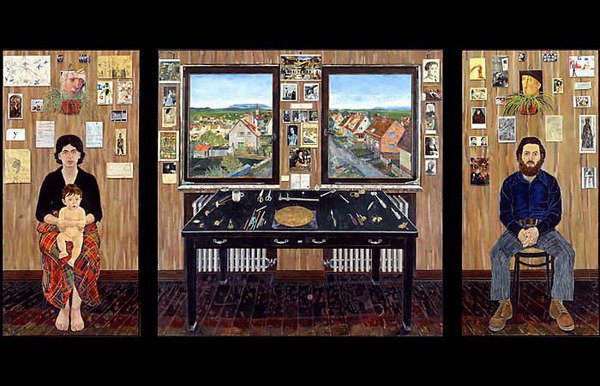Simon Dinnerstein
dal 28/4/2011 al 9/6/2011
Segnalato da
28/4/2011
Simon Dinnerstein
Tenri Cultural Institute, New York
The Fulbright Triptych. The exhibition comprised of a large square painting in its center portraying a wall in the artist's house decorated with various size pictures, and containing a horizontal work table upon which rest a series of printing trade tools.

Inasmuch as Simon Dinnerstein’s work is grounded in the human figure and line, it looks to the Classical genre. But in its attention to detail, his work relates more to the Northern Netherlandish aesthetic as seen in his Fulbright Triptych. The figure combined with abundant detail poses an antithetical contrast that differs greatly in its stylistic orientation aligning Dinnerstein’s art to the so-called tableux-vivants of the International Gothic Style. Dinnerstein’s use of gold leaf, the triptych idiom and his mannerist style are also part of this late medieval style.
Although this tripartite work is autobiographical it is entitled The Fulbright Triptych after the grant that made it possible to be realized. It is comprised of a large square painting in its center portraying a wall in the artist’s house decorated with various size pictures, and containing a horizontal work table upon which rest a series of printing trade tools. On the table surface, exactly in the middle, is an image of an oval shaped copperplate engraving entitled Angela’s Garden depicting bushes, plants, fences and walking paths. The left vertical panel shows the artist’s wife Renee holding in her lap, the couple’s yet to be born daughter Simona as a young toddler. The right panel contains the artist sitting in a chair with linked hands on his lap, spider plant hanging above him surrounded by images from various stages of art history. The images embellishing the wood paneled wall can be identified as the traditional art reference system popular among artists.
Yet in this work, because of their specificity, they signify the artist’s own history both morphological and philosophical. A good example is the spider type plant hanging above his self-portrait that by 1993 becomes a leitmotif. As used here the device prophesies the future use of this natural motif combined with self portrait in which the complex network of branches, represent the artist’s mental and complex state of reflection. Dinnerstein uses this motif repeatedly in future works such as Counterpoint, 1993, Rear Window, 1994 and his 1999 Reflection. Dinnestein is the recipient of countless honors and awards such as the First Prize from Brooklyn Museum of Art Exhibition (1967), Fulbright Fellowship from Germany, in Graphics (1970-71), Lazarus Fellow, Metropolitan Museum of Art (1976-78) and Robert Lehman Foundation Grant (1999-2000).
For More Information:
Exhibitions Director Dr. Thalia Vrachopoulos at 212-691-7978, tvrachopoulos@gmail.com,
Curator Suechung Koh at 201-724-7077, pariskoh@gmail.com,
Tenri Project Director Yuji Okui at 212-645-2800, Yuji@Tenri.org
Opening reception on Friday April 29th, from 6-8pm
Tenri Cultural Institute
43A West 13 Street, in New York City



